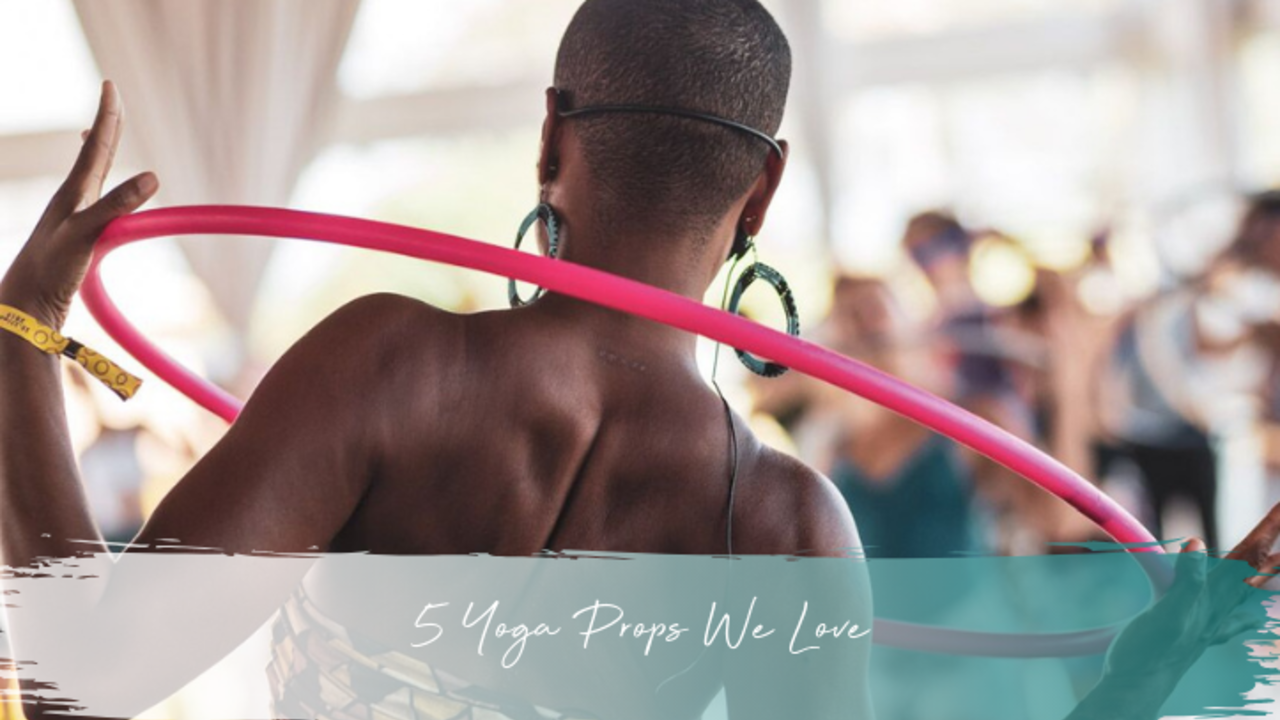
5 Yoga Props We Love
Sep 05, 2019At HoopYogini™, we don’t discriminate! We love and embrace all kinds alternative yoga styles. Adding props to your yoga practice can make it more fun, challenging, and impactful. We ask you to keep your mind open to new techniques.
5 Yoga Props We Love
The Yoga Block
Yoga blocks are an amazing tool to make challenging or uncomfortable postures more accessible. Blocks have many different uses and because of their shape, they can be placed on different sides to create 3 different heights. They can also be stacked on top of each other, used side by side—one under each foot, one under each hand, etc. Essentially, the block brings the ground a little closer to you which makes poses more accessible. For example, if your hands don’t quite meet the ground in Triangle Pose or Wide Legged Forward Fold, you can place blocks on the ground and then place your hands on the blocks. You might start with the blocks at a higher level, and then rotate them so that they are lower to the ground, allowing you to deepen the stretch without having to go all the way to the ground. Blocks can be placed on the ground as a guide for placement or symmetry. They can also be used on body such as between the knees in chair pose, or between the palms in reverse prayer pose. Click here for our recommended yoga block.
Strap
Straps are an excellent tool when you are experiencing tightness but want leverage to go deeper into the stretch. For example, if you are generally able to touch your toes in a forward fold, but experience tightness, a strap can be used to pull you closer to your feet. It’s important with the strap to listen to your body’s limits and not force yourself into the pose. Straps can also be wrapped around the body or limbs to provide stability. For example, you can wrap the strap around your arms when learning inversions such as Pincha Mayurasana, also known as Forearm Stand. Click here for a link to a functional and beautiful strap.
Hula Hoop
The hoop is a unique yoga prop. It can be used in the hands as a tool to support range of motion in the limbs and spine, it can be used as a balance tool similar to a ballet bar (yet more easy to transport than a ballet bar!) and as a stretch assist supporting deeper lengthening in traditional yoga postures. Of course, when hula hooping on the body, the hoop massages the core, and with your focused attention and pranayama, you can build a detoxifying heat that with the massage the hoop provides, helps to promote organ health. In addition, the low weight yet circular design of the hoop, when held in the hands, can be used to build tone and strength. Try these Standing Reverse Prayer Tricep Dips (bring your hands together into Prayer / Atmanjali Mudra and have the hoop rest in your hands between the pointer fingers and thumb, extend your arms overhead and then fold your elbows so your hands and hoop are behind your head in Reverse Prayer Pose. Inhale and extend your arms. Exhale and bend your elbows back into Reverse Prayer. Repeat for 6-20 reps to tone your arms. Visit our online store for HoopYogini courses and Hoops.
Yoga Wheel
Yoga wheels have gained popularity over the last few years. The wheel is great for experienced yogis who want to add additional challenges. For example, standing on top of the wheel adds an additional balance challenge. On the other hand, the wheel is also great for those who have never done yoga before. Just by learning a few simple movements on the wheel, an inexperienced yogi can get a great stretch through the neck, shoulders, chest, rib cage, upper back and lower back. The wheel is sturdy enough to provide structure and to support the full weight of the practitioner. Click here for our favorite yoga wheel.
Bolster
Essentially a bolster is a rectangular or cylindrical cushion, and they come in many sizes. Bolsters are your friend if you suffer from back pain, joint pain, or if you need to care for an injury. If you don’t have a bolster, a few folded blankets can often do the trick! Bolsters pair very well with a relaxed or slow paced yoga flow. If you’d like to hold postures for long periods of time but sometimes begin to experience discomfort, bolsters can help support some of your body weight to make you more comfortable. For example, Savansana—bolster under knees to take pressure off the low back or in Padmasana- under the seat to help straighten and lengthen the spine. Click here for a link to multi-size yoga bolsters.
Please note: Whether using yoga props or not, it is imperative that you listen to any signs from your body that you need to stop and or modify a posture. Although props can have a positive impact on your practice, it is important to use them within your means and practice safely at all times. Remember, there is no need to rush your personal yoga journey.

Written by: Erin Wood
Erin is a certified HoopYogini™ instructor who enjoys sharing her love for Hoop Yoga with as many souls as she can. Erin is passionate about self-love. She is dedicated to her mind and body! Show her some love by sharing and discussing this
Don't miss a beat!
New moves, motivation, and classes delivered to your inbox.
We hate SPAM. We will never sell your information, for any reason.

